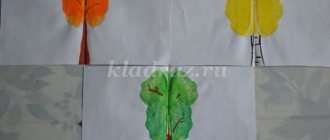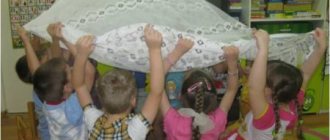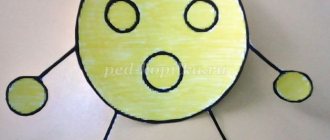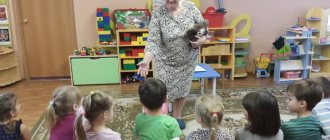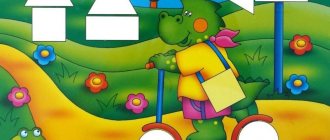Summary of GCD on the formation of elementary mathematical concepts in the middle group
Summary of GCD on FEMP in the middle group “Magic Teremok”
Program tasks: • Fix the names of geometric shapes (circle, triangle, square);
• Strengthen the ability to correlate the number of objects with a number;
• Improve counting skills within 5; • Develop memory, speech, logical thinking, imagination; • Foster independence, the ability to understand the learning task; • Develop the ability to help, friendly relationships. Equipment: Demonstration material: bibabo doll - mouse, cards with numbers and subject pictures, geometric shapes (circle, square, triangle, rectangle)
, toys
(five cubes, four nesting dolls, three bears, Masha and the bear, one hedgehog)
, four hoops , tambourine
Handouts: geometric shapes (circle, square, triangle, rectangle)
, cards with numbers.
Integration of educational areas: communication, reading fiction, health, physical education. Progress of the NOD: Educator: Children, look who came to visit us today? Mouse: Hello, guys. Do you recognize me? I am the Little Mouse from the fairy tale “Teremok”. Listen to what happened to me today. I ran to the tower, stopped and asked: “Terem-teremok! Who lives in the mansion? And the magical voice at the tower answers: “The tower will open its door only to those who complete all my tasks.” Will you help me complete the tasks given by the magical Teremok? And the tasks are as follows: Task No. 1.
“Name the geometric shapes”
- What is this?
(Square)
- Who can name this figure?
(Rectangle)
- Look carefully and tell me how a rectangle differs from a square?
(children's answers)
- How can I check?
(Place them on top of each other)
- What do we see now?
What can we say? (Two sides of a rectangle are longer than a square, and the other two are identical)
- What is the difference between a square and a triangle?
(A triangle has three angles and three sides, and a square has four angles and four sides)
- What is the difference between a circle and a square?
(A circle has no corners or sides) Task No. 2.
“Show it correctly”
(The teacher names geometric shapes, and the children pick up the geometric figure that the teacher names). Task 3.
“Find a place for the figure”
(There are four hoops on the floor, in the center of each there is a geometric figure. The teacher gives the children one geometric figure each) Educator: While I am banging the tambourine, you walk in different directions. As soon as the tambourine is silent, you need to find a hoop with your geometric figure and stand around it. (The game is repeated several times, with the children changing their figures) Task No. 4.
“Hit the tambourine as many times as the number shows”
(The teacher raises the card with the number, the child must hit the tambourine as many times as the number shows).
Physical education minute.
The cubs lived in the thicket, twisting their heads: Like this, like this
(circular movements of the head)
They twisted their heads.
The cubs were looking for honey, Together they rocked the tree: Like this, like this (raise your arms up and bend to the sides)
Together they rocked the tree.
And then they walked (walking like a bear)
and drank water from the river: Like this, like this
(body bends forward)
And they drank water from the river.
And then they danced, (“springs”)
raised their paws higher: Like this, like this
(jumping, clapping their hands at the top)
raised their paws higher.
Task No. 5.
“Count correctly”
(The teacher puts object pictures on the easel. Children must correctly correlate the number of objects with the number). Task No. 6.
“Find a house for each number”
(The teacher distributes a card with a number to each child. On five tables there are toys: five cubes, four nesting dolls, three bears, two heroes from the fairy tale “Masha and the Bear” and one hedgehog. The teacher distributes them to the children cards with a number and shows five houses where toys live. At a signal, the children find the house for their number and stand near it. The teacher together with the children checks whether everyone has found their house correctly.
You can exchange cards and play a few more times).
Educator: Guys, you completed all the tasks correctly, so the doors of the magic tower are open for the Little Mouse. Let's say goodbye to the Mouse, she needs to hurry to her fairy tale. And if Little Mouse needs our help again, we will definitely help her. Really, guys? Mouse: Thanks, guys. You helped me a lot. Goodbye. Educator: Who came to visit us today? What happened to her? How could we help her? What tasks did we complete? Did you enjoy helping Little Mouse? (Children's answers).
We recommend watching:
Summary of a lesson on the formation of mathematical concepts for children of the middle group. Notes of educational activities on cognitive activity (mathematics) in the middle group. Our flag Notes on mathematics in the middle group Notes on cognitive development in the middle group of kindergarten
Similar articles:
Math lesson notes “Number 1”. Middle group
Summary of mathematics lesson “Number 2” in the middle group
Summary of mathematics lesson “Number 3” in the middle group
Summary of mathematics lessons in the middle group. Digit 4
Summary of the lesson on FEMP “Mathematical journey into the winter forest” in the middle group
Summary of the lesson on FEMP “Mathematical journey into the winter forest” in the middle group
Author: Kuchukova Lyubov Anisimovna, teacher of MBDOU No. 44, Miass, Chelyabinsk region. Description of the material: the summary is aimed at strengthening the ability to count within five, designate the number of objects with a number, compare and equalize sets, etc. In addition, the lesson material will help consolidate children’s knowledge about the life of animals in the winter forest.
The goal is for children to be able to count within five and denote the number with a number. Objectives: 1. consolidate children’s ability to count to 5, indicate the number of objects with the corresponding number; 2. consolidate the ability to compare sets based on counting; 3. consolidate knowledge about geometric shapes; 4. practice determining the spatial position of objects. Materials and equipment: basket, silhouettes of carrots (4 pcs.), nuts, barrel of honey; silhouettes of hares (4 pcs.), Hare toy, tree silhouette, squirrel silhouette, number cards (1 pc. for each child); numbers 1-5, pasted on the lockers in the group; a screen house with number cards with five objects attached to it, envelopes with the game “Geometric Constructor” and a sample image (1 piece for each child). Progress of the lesson: Teacher. - Guys, number 5 found out that you learned to count to five, and invited you to visit. But they don’t go on a visit without gifts! We have a long way ahead, through the forest. What if we meet someone in the forest?! A discussion is held about who might meet in the forest. Children choose gifts - silhouettes of carrots, mushrooms, nuts, a barrel of honey. An audio recording with the sounds of a blizzard is turned on. Children follow the teacher, performing the following movements: - we walk through the snowdrifts, raise our legs high; - We crawl under the spruce branches. Educator. - Here we are in a forest clearing! Look, here is a bunny under a bush (the teacher draws the children’s attention to the toy – a hare). He's just kind of sad. What's wrong with him? (The teacher pretends to listen to the hare) Teacher. - Guys, it turns out that the bunny was waiting all morning for his friends - the hedgehog and the bear, but they didn’t come. The bunny doesn't know what happened? Do you know why the hedgehog and the bear didn’t come to visit the hare? (Children's answers) Educator. - You, little bunny, will now have to be friends with squirrels and hares all winter! Why guys? Children. Because they don't hibernate. Educator. - Little bunny, look what we brought you! (Shows carrots in a basket). Wow, so many! Now the guys will count how many carrots there are. Educator. - Guys, are the carrots the same size or different? (Children's answers) How do you know which carrot is the biggest and which is the smallest? Children. – You can look with your eyes, you can put carrots on top of one another and find out. Educator (on behalf of the hare). - Guys, if you meet my brothers in the forest, then give them the carrots, but I still have things to do here. Children follow the teacher. Educator. - And there are hares in the clearing! How many are there? Children. 4. Educator. - Guys, are there enough carrots for all the hares? Let's check! Children arrange hares and carrots in pairs. Educator. – How many hares didn’t have enough carrots? Children. - To one. Educator. - How to make sure there is enough for everyone? Children. - We need another carrot. Educator. – And I accidentally grabbed another carrot. Well, now all the hares are full! Guys, they offer to play with them! Game “1, 2, 3 – go to the house.” The teacher gives the children number cards from 1 to 5. Cards with numbers are pasted in different corners of the group. You need to count the number of objects on your card and find the desired number (After completing the task, the children exchange number cards, the game is played several times). The teacher draws the children’s attention to the board, where there is a silhouette of a tree with a squirrel sitting on it. Educator. - Guys, look, the squirrel is playing hide and seek with us! The teacher changes the location of the squirrel, the children answer the question “Where is the squirrel?” (on a tree, under a tree, on the right, on the left). Squirrel praises the children for finding her quickly. Educator. - Guys, the squirrel told me that she knows where the number 5 lives. Only in order for her to show us the way, we need to recite poems about the numbers that we already know. The teacher shows a card with a number. Children recite poems (book by Lopatina A., Skrebtsova M. “Fairytale Mathematics”). After this, the teacher and the children approach the screen house on which the number cards are located. Educator. - Guys, how can you guess that the number 5 lives here? Children. – There are five of all items on the cards (they count everything together). A teacher (junior teacher) appears from behind the screen, playing the role of number 5. Number 5. - Guys, it’s so good that you got to me! So you really can count to five! And I have prepared a gift for you (shows envelopes with geometric shapes). The teacher takes out one geometric figure from the envelope and asks the children to name the figure (the figures are laid out on the table). Educator. - Count how many figures there are? Children. - Five. Number 5. - Yes, in each envelope there are five figures, from which you need to make an image according to the sample. Children receive envelopes and sit at tables to complete the task. Number 5 praises children for doing it correctly. Educator. – Guys, what an interesting journey we had! Who did we meet in the winter forest today? Why didn’t we meet a hedgehog and a bear? Now it's time for us to go back to kindergarten! Interesting games and activities await us there too!
We recommend watching:
Summary of a comprehensive lesson on FEMP with elements of application in the middle group. Summary of a lesson in mathematics in the middle group of kindergarten. Synopsis of a game-based cognitive lesson on FEMP in the middle group. Synopsis of joint activities on mathematical development for children of the middle group.
Similar articles:
Math lesson “Rectangle” in the middle group of kindergarten
Mathematics lesson “Ordinal counting” in the middle group
